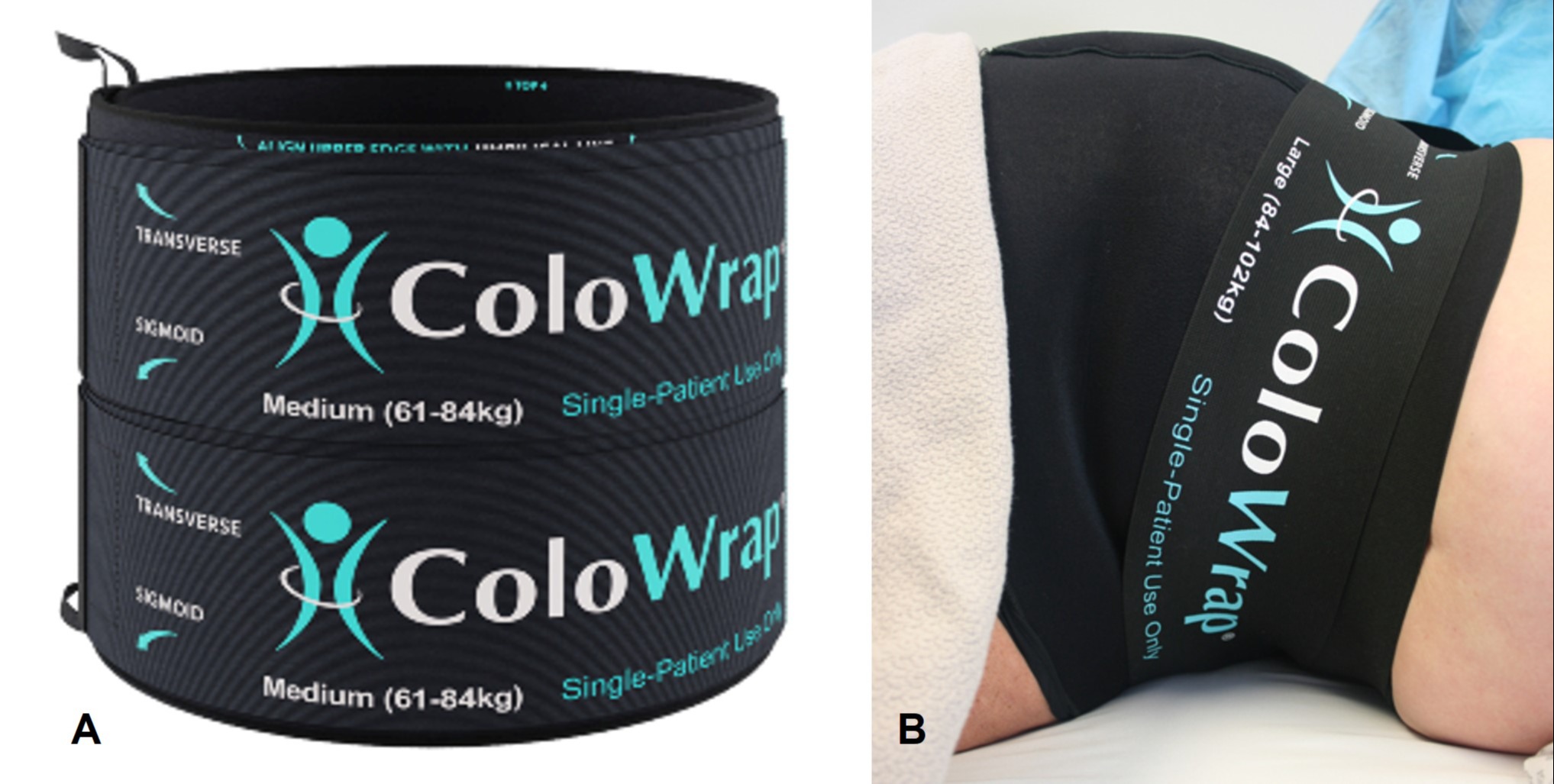Back
Poster Session C - Monday Afternoon
C0302 - ColoWrap Device Facilitates Successful Colonoscopy in Patient With Prior Incomplete Colonoscopy Due to Looping and Adhesions
Monday, October 24, 2022
3:00 PM – 5:00 PM ET
Location: Crown Ballroom
- DE
Dean A. Edwards, MD
Gastroenterology Associates of Southeast Missouri PC
Cape Girardeau, MO
Presenting Author(s)
Dean A. Edwards, MD
Gastroenterology Associates of Southeast Missouri PC, Cape Girardeau, MO
Introduction: Two primary causes of incomplete colonoscopy related to patient anatomy include redundancy and post-surgical adhesions. This case report details on the successful completion of a previously failed colonoscopy in a 70-year-old obese male patient with a redundant colon and prior abdominal trauma (gunshot wound) using a colonoscopy compression device (ColoWrap®).
Case Description/Methods: A 70-year-old obese male patient with a history of abdominal trauma (gunshot wound) underwent surveillance colonoscopy in November 2021. During the procedure, significant looping occurred once the scope was advanced past the distal colon, inhibiting progress beyond the hepatic flexure. All standard measures including torquing, manual abdominal pressure, and patient repositioning were employed yet were unsuccessful and after one hour the procedure was aborted.
The patient thereafter underwent virtual colonoscopy which indicated a lesion in the ascending colon. The patient was scheduled for a repeat colonoscopy in January of 2022 with the same experienced endoscopist.
Due to prior difficulties, the physician decided to perform the patient’s repeat attempt at colonoscopy using a ColoWrap. ColoWrap is a single-use lower abdominal compression device designed to help mitigate looping during colonoscopy. The device applies broad, sustained compression across the lower abdomen and features two secondary straps that can be used to direct additional, location-specific pressure. The ColoWrap was applied just prior to the exam per manufacturer instructions. Looping was once again encountered past the distal colon. In response, the ColoWrap secondary straps were adjusted to apply directed compression to the areas of presumed looping in the left and the transverse colon. This enabled successful advancement past the hepatic flexure and to the cecum. The lesion that had been indicated on virtual colonoscopy was identified and biopsied. The biopsies revealed a large, high-risk adenoma not amenable to endoscopic removal and surgery was performed.
Discussion: In this case, use of ColoWrap enabled successful cecal intubation in a patient with a previous incomplete colonoscopy who had a known proximal colonic lesion identified by virtual colonoscopy. ColoWrap's intra-procedural adjustability and features delivering targeted compression to specific regions of the abdomen were instrumental in overcoming the anatomical difficulties that had resulted in the failure of the prior colonoscopy performed by the same, experienced endoscopist.

Disclosures:
Dean A. Edwards, MD. C0302 - ColoWrap Device Facilitates Successful Colonoscopy in Patient With Prior Incomplete Colonoscopy Due to Looping and Adhesions, ACG 2022 Annual Scientific Meeting Abstracts. Charlotte, NC: American College of Gastroenterology.
Gastroenterology Associates of Southeast Missouri PC, Cape Girardeau, MO
Introduction: Two primary causes of incomplete colonoscopy related to patient anatomy include redundancy and post-surgical adhesions. This case report details on the successful completion of a previously failed colonoscopy in a 70-year-old obese male patient with a redundant colon and prior abdominal trauma (gunshot wound) using a colonoscopy compression device (ColoWrap®).
Case Description/Methods: A 70-year-old obese male patient with a history of abdominal trauma (gunshot wound) underwent surveillance colonoscopy in November 2021. During the procedure, significant looping occurred once the scope was advanced past the distal colon, inhibiting progress beyond the hepatic flexure. All standard measures including torquing, manual abdominal pressure, and patient repositioning were employed yet were unsuccessful and after one hour the procedure was aborted.
The patient thereafter underwent virtual colonoscopy which indicated a lesion in the ascending colon. The patient was scheduled for a repeat colonoscopy in January of 2022 with the same experienced endoscopist.
Due to prior difficulties, the physician decided to perform the patient’s repeat attempt at colonoscopy using a ColoWrap. ColoWrap is a single-use lower abdominal compression device designed to help mitigate looping during colonoscopy. The device applies broad, sustained compression across the lower abdomen and features two secondary straps that can be used to direct additional, location-specific pressure. The ColoWrap was applied just prior to the exam per manufacturer instructions. Looping was once again encountered past the distal colon. In response, the ColoWrap secondary straps were adjusted to apply directed compression to the areas of presumed looping in the left and the transverse colon. This enabled successful advancement past the hepatic flexure and to the cecum. The lesion that had been indicated on virtual colonoscopy was identified and biopsied. The biopsies revealed a large, high-risk adenoma not amenable to endoscopic removal and surgery was performed.
Discussion: In this case, use of ColoWrap enabled successful cecal intubation in a patient with a previous incomplete colonoscopy who had a known proximal colonic lesion identified by virtual colonoscopy. ColoWrap's intra-procedural adjustability and features delivering targeted compression to specific regions of the abdomen were instrumental in overcoming the anatomical difficulties that had resulted in the failure of the prior colonoscopy performed by the same, experienced endoscopist.

Figure: A. ColoWrap Anti-Looping Colonoscopy Compression Device B. ColoWrap in-situ (previous, single-strap version)
Disclosures:
Dean Edwards indicated no relevant financial relationships.
Dean A. Edwards, MD. C0302 - ColoWrap Device Facilitates Successful Colonoscopy in Patient With Prior Incomplete Colonoscopy Due to Looping and Adhesions, ACG 2022 Annual Scientific Meeting Abstracts. Charlotte, NC: American College of Gastroenterology.
